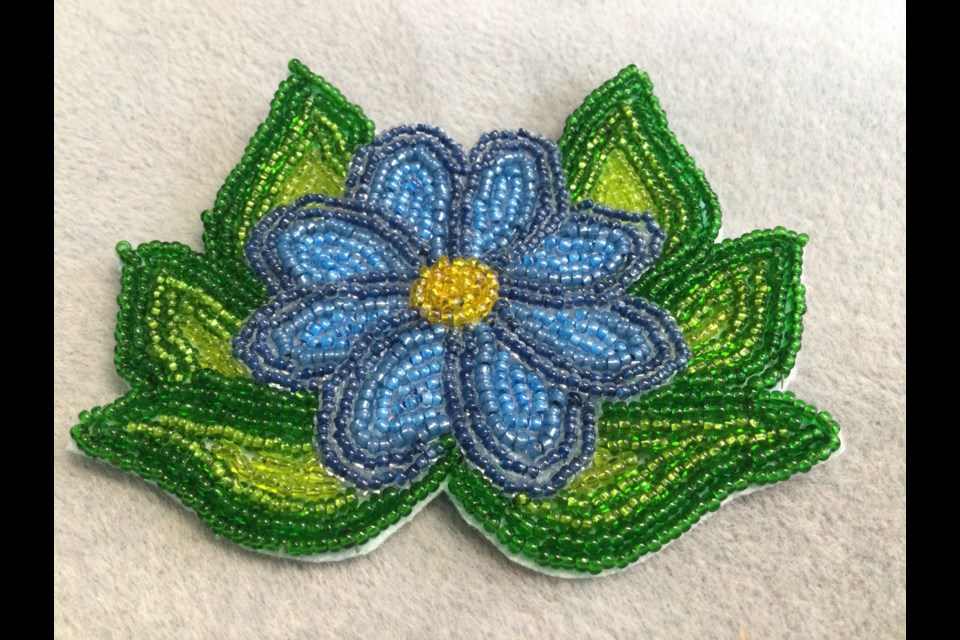When Liz Eshkibok, cultural practitioner at Shkagamik-Kwe Health Centre, first “became a woman” — or so the euphemism goes — she began her “berry fast.” Originally from Wiikwemkoong Unceded Territory, she was given, she said, “woman teachings.”
“Berry fasting is a traditional right of passage that Anishinaabe girls go through at the age of puberty,” said Eshkibok, “when they first receive their menstrual cycle.”
When Eshkibok began her fast, she was given teachings.
“I went out to a lodge with an Auntie,” she said. “She sat with me and gave me woman teachings. She talked with me about medicine, about quill work, about sewing and all these different teachings that can bring a woman peace. And she taught me beadwork.”
But beadwork to Anishinaabe people, and many Indigenous people for that matter, is much different than it is for many other cultures — especially Eurocentric ones, where the focus is often on the finished project.
For the Anishinaabe, the creation of the piece is almost less important than the energy imbued into it during its creation. Far from a ‘stitch-and-bitch’ session, beading is to be done with a sense of peace, something that you create while you think of the person you are creating it for — even if that person is yourself.
It is a time to think of your love for the person, the joy you would like them to take from the piece — or even the protection it can bring. The importance of beadwork in the culture is clear from the name of the practice itself, which also happens to be the name of the workshop Eshkibok hosts over Zoom and through Shkagamik-Kwe Health Centre: Manidoo-Minenhnsag, or ‘spirit beads.’
“Our Indigenous creation stories say that the Creator created each one of us individually, and that he created the most beautiful Anishinaabe person that he could imagine,” Eshkibok said. “What he created is us.”
She said that remembrance of the traditional stories puts creation, and the joy of it, into their hands. So, through the spiritual act of beadwork, Manidoo-Minenhnsag pays homage to all of creation itself.
“You are the creator,” Eshkibok said. “What are you going to create with this spirit seed?”
When the beading workshop first began, it was pre-pandemic. There were tables in a main gathering room where everyone could work, visit and feel renewed within their community. “We're hosting this relaxing, peaceful, spiritual, even atmosphere, so that you can breathe peaceful, calm, kind energy into this beadwork piece that you are creating.”
But that has, of course, changed with the coronavirus.
The workshop is now hosted via Zoom, and while it can be a bit of an adjustment — Eshkibok says she has offered a great deal of tech support — it is a chance for the people who love beadwork to work with spirit seeds, and it is a chance for both Indigenous and non-indigenous community members.
Eshkibok wanted to find a way to continue the program, because she felt that the times when we are struggling can be a good time to pick up beadwork.
“Our medicine wheel has four quadrants,” Eshkibok said. “The quadrants are physical, emotional, mental and spiritual. I would argue that beading can fit into everyone one of those.”
It did for Eshkibok. When she felt she was at her lowest, struggling with grief and mental illness – and with a waiting list separating her from support — she filled her time with beading.
“I didn't have a job. I was unhomed and on a year-long waiting list to access mental health services,” she said. “But I had this big, beaded piece to work on. It's a woman's traditional top — the whole thing has to be beaded. And so, every day, I just sat down and I did my beading.”
She took breaks when the grief would overcome her. She would stop, cry and then pick up her work again.
She put her work down again during the beginning stages of the pandemic.
“I didn’t feel in a good space mentally, to be creative or to put that energy into my work. I think it was in the fall when I finally felt I could pick it up again.”
It’s not just the importance of your work to you, but of you to your work and the energy that flows both ways.
“We're always encouraging our participants to be to be mindful, to be prayerful, and to be in a really good space when they pick up their beadwork, so that it's full of that good energy, and it's full of that good prayers and, you know, good, kind feeling,” said Eshkibok.
But now, Eshkibok has picked up the woman’s teaching once again and began offering the class via Zoom. It’s because it is her self-care, and she would like to offer it to others as well.
As she makes her tea and picks up her work, you can join her via Zoom every Tuesday from 1 p.m. to 3 p.m. For more information visit www.skhc.ca.
Jenny Lamothe is a Local Journalism Reporter at Sudbury.com, covering issues in the Black, immigrant and Francophone communities. She is also a freelance writer and voice actor.
